On Making Life Livable: The Democratization of Comfort
for the American Society for Heating, Refrigerating, and Air Conditioning Engineers, ASHRAE,
Past President's Dinner, HESS Building, 6:00 PM, Tuesday, January 22, 2002
by John H. Lienhard
Mechanical Engineering Department
University of Houston
Houston, TX 77204-4792
713-743-4518
jhl [at] uh.edu (jhl[at]uh[dot]edu)
Our business, yours and mine, as engineers, is to make life livable. And, to put that problem into perspective, I'll begin with two anthropologists, Malcom Smith and Robert Layton. They tell a strange tale about the integrity of the human species. They visit an African lake that teems with strange fish called cichlids. The cichlids in the lake come in two hundred different species. They're all pretty similar. Only their lips, jaws, and teeth have each evolved differently.
 Some became fin eaters -- some worm eaters. Some cichlids eat snails. Each evolved into a tiny niche of the ecology. That kind of subdividing is pretty common. That's why we count some forty thousand species of fish, birds, and mammals.
Some became fin eaters -- some worm eaters. Some cichlids eat snails. Each evolved into a tiny niche of the ecology. That kind of subdividing is pretty common. That's why we count some forty thousand species of fish, birds, and mammals.
So why didn't we splinter like that? We are only one species. One hunter can chase down a rabbit; another can spear a fish. Yet we have not specialized into separate races of rabbit catchers and fish spearers. Why are we alike in all but the most minor features -- like skin color or hair diameter?
We're not like the fish in that African lake. We live in every environment on Earth. It seems obvious that we should've become one species of Arctic dwellers and another of Saharans. The reason we haven't lies in one key attribute. Humans share! We share in complex ways that no other animal does. Back in camp, the rabbit chaser and the fish spearer exchange food. We've done that as long as we've existed.
Of course, it helps that we're very omnivorous. We eat almost anything. If it lives, we've eaten it, at one time or another. More important, we've also shared it. But our sharing goes far beyond food. The truly important commodity that we share is our knowledge of our techniques for gathering food or fulfilling any other needs. One cichlid fish had to develop a specialized jaw for crushing and eating snails. We're able to share our knowledge of snail crushing.
That's what technology is. It's the combination of tecnh, which is Greek for art and skill in making things, with -ology -- the lore, or science, of technique. Technology is the means by which we share technique. It is the primary act of sharing.
It's also what ASHRAE is all about -- this is the society within which all of you share your techniques for making life livable. You all understand, as well as anyone, that technology shapes us into one species. We're bound in a unique and instinctive tether of generosity, with our technologies located right at the core of that generosity. If we were to place a naked human being in Alaska or the Sahara, that person would die without the blessing of your shared techniques. Humans evolved to fit only one specific environment -- the warm Savannah of Central Africa. We left that Garden of Eden only after we'd eaten the fruit of shared knowledge.
We took up implements and clothing. And we moved out over the Earth -- first Northeast into Asia Minor -- then beyond. All the while we learned and shared more and more of the techniques that would ultimately let us survive in the worst climates Earth had to offer.
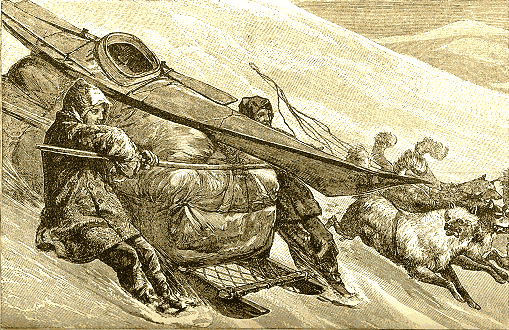
So let's look at some of the issues of sustaining acceptable heat and cold in our lives. Since the creation of artificial coldness is our greater concern here in hot Houston, I'll begin in an odd place. I'll begin with a visit to my great-aunt at her old farmhouse in Minnesota. Those visits were a childhood delight -- drinking in nineteenth-century smells and textures. Best of all was the taste of her home-made ice cream, rich with eggs and cream.
Back in the city, at the corner grocery, I could buy three large scoops of the factory-made stuff for a nickel. It wasn't Aunt Mary's artery-clogging ambrosia, but it was still wonderful. Ice cream was among my primary pleasures in the 1930s.
Ice cream was around long before commercial vapor-compression refrigeration systems started becoming commonplace in the 1870s. It didn't wait for that. At first, wealthy Romans had snow, packed in straw, brought down from the mountains, flavored with fruit, and served at banquets. But that still had the texture of ice crystals. It lacked the body of a dairy product. Roman ices were a far cry from ice cream.
Marco Polo found a recipe for a milk-based ice in thirteenth-century China. From then through the eighteenth-century, closely-guarded ice-cream recipes traveled the royal houses of Europe. King Charles I of England mandated that they not be served at anyone's table but his. This was no food for commoners. Washington, Jefferson, and Madison all served ice creams at affairs of state.
Like government itself, ice cream was about to be democratized, but it was still a terribly labor-intensive product. You have to hold a gluey mixture at a sub-freezing temperature while you steadily stir it to keep ice crystals from forming. Good ice cream is a texture as much as it is a taste. Making it is a process -- not just a recipe.
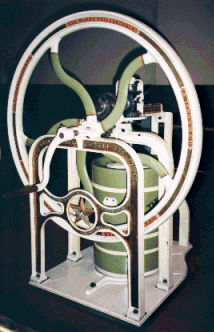 Nevertheless, ice cream became an expensive public delicacy in our new country. During the early nineteenth century, you could buy it in New Orleans shops -- even off in the far wilderness of Kentucky. Nancy Johnson of Philadelphia made the big breakthrough in 1843. She patented the home ice-cream freezer. Then she sold the patent for $200. By 1873 some seventy copycat patents had been filed.
Nevertheless, ice cream became an expensive public delicacy in our new country. During the early nineteenth century, you could buy it in New Orleans shops -- even off in the far wilderness of Kentucky. Nancy Johnson of Philadelphia made the big breakthrough in 1843. She patented the home ice-cream freezer. Then she sold the patent for $200. By 1873 some seventy copycat patents had been filed.
After that, ice cream became an American staple. Jacob Fussell, an abolitionist Lincoln supporter, set up the first ice-cream factory in 1856. The ice-cream soda and the ice-cream sundae followed. The ice-cream cone was patented in 1903. It took off in America after it proved to be the most popular treat at the 1904 World's Fair in St. Louis.
So what I saw at my great aunt's house was the passing on of the old nectar of Caesars and kings. What I enjoyed at the corner store was ice cream finally gone fully public. America had, at last, given all of us a joy once allowed only to royalty and their courts.
Now, it might seem frivolous to begin with ice cream, but I use it to reach my concern with the matter of democratization. Being able to bear heat or cold is a need shared by rich and poor alike. It is precisely in making it possible for all of us to satisfy that need that you so powerfully serve the world around you.
Let me try another seeming frivolous case of democratization and climate control. This is something I began thinking about a decade ago when my wife and I picked up a fifty-dollar kit at Sams. It was a large box of precut redwood boards and brass fittings.
When we assembled it, we had a glider-style love-seat. The motion of a glider seat is very comfortable. And for a good reason! It has to do with your semicircular canals. Any time you turn your head while your body is moving in a curved path, you activate something called a Coriolis force in the fluid of your inner ear.
That force moves that fluid deceptively. It sends a wrong signal to your brain. You think you aren't moving the way your eyes say you are. The result is motion sickness. The best way to trigger motion sickness is to turn your head in a lurching car or plane. That's also true in a conventional swing. I'm very bad that way. Who doesn't love to be in motion! But even rocking chairs bother me.
Porch gliders use a mechanism that's both simple and subtle to avoid that curved motion. The seat hangs in a frame. The front and back swing from different points. The seat stays nearly level as it moves to and fro. The word glider fits. You really do seem to glide. And the motion doesn't make you seasick.
Architectural historian Margaret Culbertson writes about porch gliders. She finds the earliest version in an 1898 Ladies Home Journal. From then to 1925 inventors varied the theme. They used names like "Couch Hammock" and "Swinging Davenport." Porch gliders took their present form about the time a 1925 inventor gave us this new use for the word glider. He called his version a "Glide Hammock."
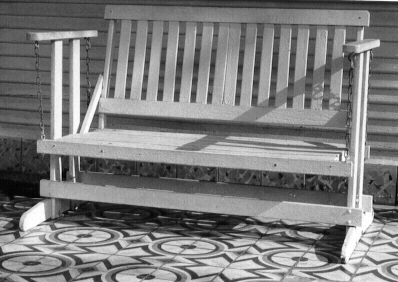
A typical porch glider. Photo by Margaret Culbertson
And what was all this glider business about? It was about giving us means to use our front porches in hot weather. It was about creating a comfortable cooling motion. The porch glider was the face of hot weather comfort in the 1920s. But then, you all changed the face of America. You gave us domestic air conditioning, and we moved off our porches. We no longer faced outward toward our neighbors. TV and air conditioning took us indoors or into our automobiles. Like any new technology, air conditioning reshaped us. And we are no longer a front-porch people.
Now, hang onto that idea, as I ask you to join me in a visit I made to San Antonio one hot August day about ten years ago. I'd gone there to name the Milam Building as a Mechanical Engineering Landmark. And I shall never forget the ghostly frisson that I felt as I left the hot street and entered the cool halls of this fine old 21-story Art Deco building. As if by witchcraft, the weather changed from awful to pleasant as I entered.
That's something that we've all experienced, a thousand times. But this moment was different. For what I'd encountered was no ordinary witchcraft. You see, this was the first air-conditioned office building in the world. Inside, I met representatives of the Carrier Corporation. They were quite proud this day. In 1928, their company had installed the original system here. Of course everyone invoked the name of Willis Carrier. So let's meet Carrier.
 He was born in 1876, descended from an Andover, Massachusetts, woman who was one of those hanged as a witch at Salem. Carrier's mother also had some of that creative witchcraft. She had a mechanic's instincts. Carrier learned about math and machines from his mother.
He was born in 1876, descended from an Andover, Massachusetts, woman who was one of those hanged as a witch at Salem. Carrier's mother also had some of that creative witchcraft. She had a mechanic's instincts. Carrier learned about math and machines from his mother.
Willis Carrier was poor. He waited tables, earned scholarships, and sold stereopticon slides to get through engineering school at Cornell. In 1901, he went on to work for the Buffalo Forge Company. There he designed heating and cooling equipment. And he soon saw how little we knew about regulating the temperature and humidity of air.
So he went to work on the problem. By 1911, he'd written the science of psychrometry. He showed us how to deal quantitatively with air temperature and humidity. But he did much more. He'd already begun creating a technology for controlling the condition of the air around us. In 1907, Buffalo Forge saw the value of his work. They formed The Carrier Air Conditioning Corporation of America as a subsidiary.
And air conditioning spread across America. First theaters and churches -- then more complex structures. If you're old enough, you remember those first air-conditioned movie theaters with blue ice cubes painted on their marquees.
The Newcomen Society met in 1949 to honor the witchcraft by which Carrier had changed our lives. The Bishop of Central New York, himself a member of that historical society, stood and intoned,
For the resource of the inventor,
for the will of the worker,
and for the initiative of the industrialist, ...
We thank Thee, O Lord.
Carrier died a year later. Now, every summer as the Houston temperature climbs, I too say "Thank God!" for the witchcraft that makes this sultry climate so pleasant all year round.
Well, so much for cooling; what about heating? There, too, the theme of democracy wreathes its way around the problem of making life livable. You hear that idea being sounded in the Christmas carol,
Good King Wenceslas looked out,
On the Feast of Stephen,
When the snow lay round about,
Deep and crisp and even.
And you know the rest: How he found a poor man scratching about for wood to burn in his cold hut. You know how Wenceslas and his page gathered him in to be warmed and fed in his castle.
Now that carol was from the nineteenth century, but Wenceslas was a real enough tenth-century King of Bohemia. His own brother finally murdered him to gain the crown, but Wenceslas was eventually sainted for his charitable works and for promoting Christianity.
And his trip into the cold, whether real or mythical, took place on December 26th -- the feast of Saint Stephen. That was a poor night to be out in Bohemia in the early tenth century. Europe would warm up in the following century. But now it was cold. Five hundred years later, when it'd grown cold once again, the fifteenth-century poet François Villon shivered as he called that time of year
... the dead season when wolves live off the wind,
and people stay home near the fire ...
Even life indoors was pretty ghastly in Wenceslas' times. We needed far better tools of survival before we'd ever build a proper civilization in Northern Europe.
Europe was then a land of wood. Long before, her stone-age builders had developed wooden houses, fine pottery, and articulate tools of stone and wood. They developed the largest building made for human occupancy -- the European long-house. In 2000 BC, a typical 130-foot long-house near present-day Cologne served people, cattle, and utility functions.
I saw such a house when I visited my great-grandmother's old home in Austria. It was also a long-house, but it had been bent in four right-angle turns to form a square around an open courtyard. It still housed all the farm functions under one roof. You could walk from the parlor to the barn without going outside. Manure, stacked in that courtyard, gave off heat to the house around it as it decomposed through the winter and turned into fertilizer.
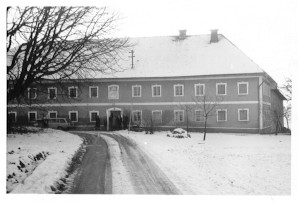
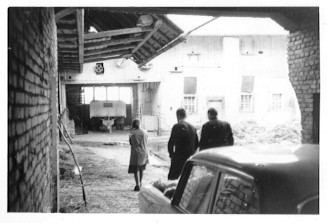
The 18th-century Klingelmuller house in central Austria -- a squared longhouse. Above/left: the view from outside. Below/right: Central court, warmed by a manure pile.
Much of Wenceslas' world was still present, but a key invention had now arisen, one that was essential before life could become more than bare survival in cold Europe. That was the chimney.
Before chimneys, whole families crammed into one large room with an indoor fire. They were utterly without privacy. They vented the smoke, but that arrangement was far less efficient than, say, a fire in an Indian wigwam.
Chimneys and fireplaces changed all that. Hot smoke in a chimney buoys up and draws fresh air into a small fire. Now we could divide buildings into rooms. And we could equip each room with a fireplace and chimney.
The first stage of that arrangement turned up in a Swiss monastery in AD 820, not long before Wenceslas. A system of flue pipes took smoke from several fires. They fed it into three smokestacks. Individual chimneys and fireplaces followed, but we're not sure just when. Evidence is very skimpy before AD 1100.
That's because only the clergy and the clerks of kings wrote in the Middle Ages. They told about politics and wars and hardly mentioned the real agents of social change. The craftsmen who really shaped the world stayed anonymous and invisible. Kenneth Clark's great television series Civilisation described the world just after the chimney was invented. He didn't talk about chimneys, either. But his title was The Great Thaw.
That was imagery for the eleventh-century artistic and technological revolution that took place after the European climate began improving. The first step on the road to building that civilization was easing human misery -- seeing some relief from cold and hunger.
And so I'm here tonight to say, simply, that we never would've built cathedrals, or lunar landers, until we'd first learned the technologies of our own survival. And not for princes and wealthy merchants, but for everyone. We engineers made modern Europe when we democratized comfort. You made Houston into a great city when you made it bearable in the summer. We engineers and technologists made humankind into a single species -- precisely by making life feasible in every climate on the face of this Earth.
SOME SOURCES
Smith, M.T. and Layton, R., On Human Nature. The Sciences, January/February 1989, pp. 10-12.
Funderburg, A., The Inside Scoop. American Heritage of Invention and Technology, Vol. 11, No. 3, Winter 1996, pp. 44-49.
Singer, C., Holmyard, E.J., Hall, A.R., and Williams, T.I., A History of Technology, Vol. 5. New York: Oxford University Press,1958. See entries indexed under foods/refrigeration.
Culbertson, M., E-Z Glider, Cite, Spring, 1992, pp. 30-32.
I don't have a citation for the mechanisms of motion sickness. Colleagues in the Wenner-Gren Aeronautical Laboratory at the University of Kentucky told me about that during the late 1960s. Working under contract with NASA, they studied motion sickness among primates in large centrifuges. They explained to me how the Coriolis force worked in the inner ear.
Wampler, C., Dr. Willis H. Carrier: Father of Air Conditioning. New York: The Newcomen Society of England, American Branch, 1949.
Ingels, M., Willis Haviland Carrier: Father of Air Conditioning. Garden City: Country Life Press, 1952. (Two matters of interest here: The author, Margaret Ingels, was the first woman graduate of the University of Kentucky. This book also has a Foreword by Cloud Wampler, the author of the Newcomen Lecture, above. Wampler was then president of the Carrier Corporation.)
Anderson, O.E., Jr., Refrigeration in America: A History of a New Technology and its Impact. Princeton: Princeton University Press, 1953.
See also, The Milam Building. San Antonio, Texas, New York: ASME Book No. HH9106, 1991.
Dresbeck, L.R. Winter Climate and Society in the Northern Middle Ages: The Technological Impact. Humana Civilitas: Sources and Studies Relating to the Middle Ages and the Renaissance, Vol. I. On Pre-Modern Technology and Science (B.S. Hall, D.C. West, eds.) Malibu: Undena Publications, 1976.